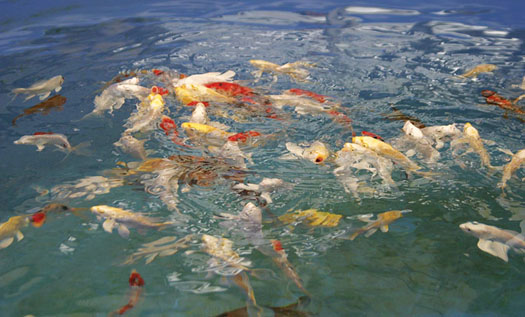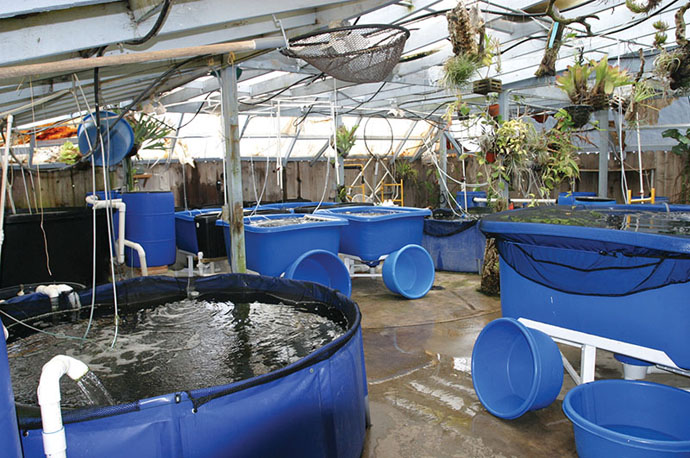
Koi sleeping disease is an infrequently discussed viral disease in koi that has been around for many decades. Most koi health books written in Japan mention this disease, but it seems that many U.S. koi dealers have heard of it but do not really understand it. I would venture to say that most koi hobbyists know nothing of it. Members of the Shinkokai Breeders and Dealers Association in Japan and the United States are well aware of this disease.
The scientific community calls this viral disease Carp Edema Virus (CEV). Electron microscopy suggests it is a pox virus. It seems to only affect koi. I would compare it to the common human flu. Koi may succumb to it with new additions to the pond, in times of stress and in cooler water below 70 degrees. If misdiagnosed or left untreated, koi can die — especially younger koi. If properly diagnosed and treated early, it can be easy to treat. Note that there is a limited number of scientific studies for this disease. The anecdotal information in this article comes from 30 years of importing koi.
Diagnosing Sleeping Disease
Sleeping disease is most commonly associated with 1-year-old koi, or tosai. Anecdotal evidence suggests it can affect any age group, but like the human flu, it is especially dangerous for the young and old. It most commonly affects the gills. The obvious symptom is lethargy, with the koi lying over on its side with fins clamped, as if it is sleeping. The koi may also appear to be floating at the surface on its side or hanging with its tail down or up. Because it affects the gills, in advanced stages, the eyes may appear to be sunken in. In general, the fish will have excessive white mucus over the entire body and in the gills. If left untreated, these symptoms may persist for over a week before koi begin to die.
These symptoms can be similar to a parasite infestation. Sleeping disease will affect weak koi, and so quite often, parasites will be present as well. Proper diagnosis requires ruling out parasites with a microscopic exam. The virus is not easily controlled by the typical parasite medicines on the market. So regardless of whether or not you have treated for parasites, the koi just get worse. Because the eyes are sunken and gills affected, it could also be misdiagnosed as a bacterial gill disease. However, with bacterial gill disease, the koi do not typically lay over as if they are sleeping. That being said, the longer the sleeping disease is left untreated, the more likely bacteria will begin to grow in the gills and end up being what eventually kills the fish.
Early Treatment
Think of it in this way: it’s as if the koi catch the flu, and if left untreated, it can turn into pneumonia. So, diagnosing it is a process of elimination, but be careful with diagnosing based on assumptions. Otherwise, as panic sets in, it can be commonly misdiagnosed as Koi Herpes Virus, or KHV. KHV is not easy to treat, but sleeping disease is easy to cure if treated early.
Because this disease is worldwide, koi breeders in Japan will purposely inoculate their 1-year-old tosai koi with this virus in order to build natural immunity. When baby koi are around five to six months old, the breeder will add one or more 2-year-old koi to the same tank as the babies. These 2-year-old koi were previously exposed and naturally immunized to the virus. The baby koi catch the virus and exhibit symptoms of sleeping, floating or hanging at the surface. White mucus is evident, and gills become pale. At this point, the breeder raises the water temperature to between 76 to 82 degrees. Rock salt is added to the pond at a dose of 0.5 percent (or up to 0.7 percent). Occasionally antibiotics like nitrofurazone or Elbagin are added to help prevent secondary bacterial infection. The elevated temperature increases the immune response. Basically, the heat gives the fish a fever.

The rock salt dries out the excess mucus, which is very important. In my experience, the mucus in the gills causes additional weakening, since the fish will have difficulty breathing and osmoregulating. The longer the koi struggles with excess mucus in the gills, the more likely it will get a gill bacterial infection. The salt is a wonderful aid in helping weak gills. Within a few days to a week, although some koi will die, most of the baby koi will have recovered. The longer the babies stay in the elevated temperature and rock salt, the stronger the immunization will be.
Because it is similar to the flu virus, the koi are not really strong enough to sell for a few weeks. Once the babies have gone through this immunization and recovered, the breeder will actually announce to the buyer that the koi have received the sleeping disease and are ready to sell. If his babies have not gone through this immunization, the breeder will notify the buyer to please wait until the process is finished.
Beyond Immunization
One would think that all would be well once the babies have been naturally immunized. But as with most things involving nature, and especially koi and viruses, you cannot let your guard down. Recent discussions with multiple breeders in Japan indicate that there may be more than one strain of sleeping disease. Again, similar to the flu, a different strain pops up every few years. After all, viruses are always mutating. In fact, it has been suggested that multiple strains of sleeping disease may exist around the world. So, a domestic koi could be immune to its own strain of sleeping disease but not to one from Japan or Taiwan, and vice versa. Koi coming from a certain breeder may not be immune to a strain found in the koi coming from another breeder. In fact, if we take it another step, the koi you purchased five years ago may have natural immunity to the virus from five years ago, but not to today’s virus.
Fortunately, koi between 2 and 4 years old are very strong if kept in a healthy pond. So we don’t typically see mature koi getting sleeping disease from new babies. However, koi isolated for five years or more may indeed catch this disease from any new koi.
Most koi dealers and experienced hobbyists know of the syndrome whereby one new koi is added to an older, isolated population, and all the old koi get sick, but the new koi remains fine. Some of you may call this the “koi in the plastic bubble” syndrome. All the older koi lay on the pond floor or float. They stop eating, get covered in mucus and will die if nothing is done. No parasites can be found under the microscope. Could this also be sleeping disease? I believe it is. I say this simply because I have been able to treat this “old koi versus new koi” disease with warm water and salt at 0.5 to 0.7 percent every time. Remember, treating early is key. If you have a customer with older fish and no new additions for more than four years, you should look out for this problem and help the customer avoid difficulties.

Dealer’s Quarantine Protocol
The most common occurrence of sleeping disease is at the dealer’s facility with new shipments of young koi during the springtime. This ailment is treatable if you are prepared for it and treat early, as in preventively. First, heat the quarantine pond to 76-82 degrees. Add rock salt at a rate of 5 pounds per 100 gallons to a concentration of 0.6-0.7 percent. Keep koi in this temperature and salt level for a minimum of two weeks.If you get koi from multiple sources, you can introduce a few fish from each batch together to purposely inoculate. Maintain the mix with temperature and salt for two to three weeks.
Hobbyist Pond Protocol
For hobbyists who do not have plants or excess algae in their pond, wait to add koi until the warm summer months or early fall, unless there are heaters present. Temperatures and immune systems will be high. Mixing new koi with old koi in the winter may prove difficult. Be sure that the old koi are nutritionally healthy and that the pond and filter are low in organic waste. This works a lot better in a clean-bottom pond versus a gravel-bottom pond.
>> Related Content | More on the Koi Sleepy Disease
Then, add rock salt. This step can only be done in a fish-only system. Do not add rock salt to a pond full of algae or aquatic plants. It will prove disastrous. For a fish-only system, add salt over two days to a dose of 40 pounds per 1,000 gallons. Check it with a new salt meter. This will bring the concentration to 0.5 percent. This is your minimum effective salt level. Over the next few days, add 10 more pounds per 1,000 gallons (50 pounds total) to a concentration of 0.6 percent. You can go up to 0.7 percent if needed. Keep this concentration for a minimum of two weeks after the koi are eating again.
If the pond has aquatic plants or an algae system, give the affected koi a daily salt bath in a separate tank. Add 1 pound of rock salt to 5 gallons of pond water in a separate tank. This will give a concentration of 2 percent. Gently catch the koi and transfer them to the salt bath. Bathe for two to four minutes, depending on the strength of the koi. A strong koi can handle five minutes, but a weak koi might need to come out in only one minute. Repeat the salt bath daily for one to two weeks. As the fish gets stronger, it can stay in the bath longer. Try to work up to four minutes. The strong salt helps dissolve the mucus on the gills.
Along with the daily salt bath, you can also dose the pond every three days with a formalin-malachite green treatment for a minimum of five doses or more. This also helps to reduce some mucus and prevent potential parasites or columnaris bacteria. For an aquatic plant or algae pond, I have also heard success in using daily baths of Minn-Finn or potassium permanganate, or dosing with Chloramine-T. The goal is to remove excess mucus in the gills. These treatments work better if the water temperature is above 72 degrees.
Treat Proactively
Remember we are dealing with a virus, and there is no known treatment for viruses other than the natural immune system. The warm water strengthens the immune system, and the salt reduces the mucus so the fish can breathe and osmoregulate. You may not be able to wait for warm water. If you can add the salt in advance or shortly after the symptoms show, you can still have success with just the salt treatment alone. Warm water speeds up the process and builds immunity. Always treat proactively for best results.



Cam koi sleeping sickness infect the rest of your koi ?
Hello! Thank you for this information, a very big help 🙂
Very good information indeed.
Thank you.